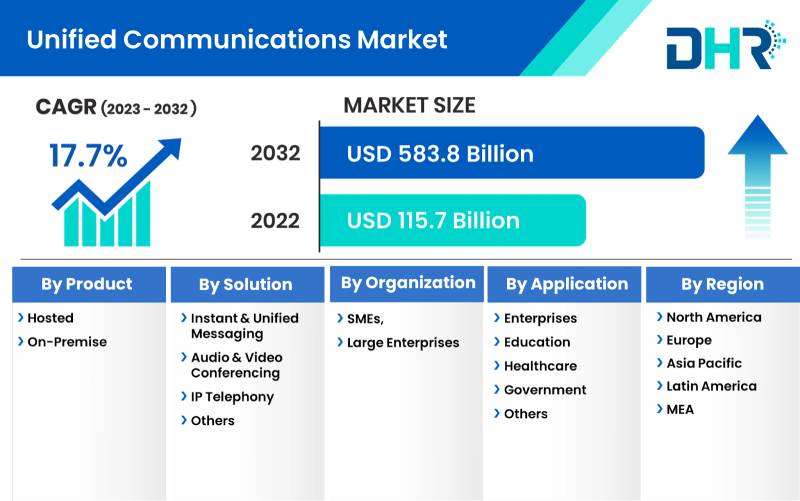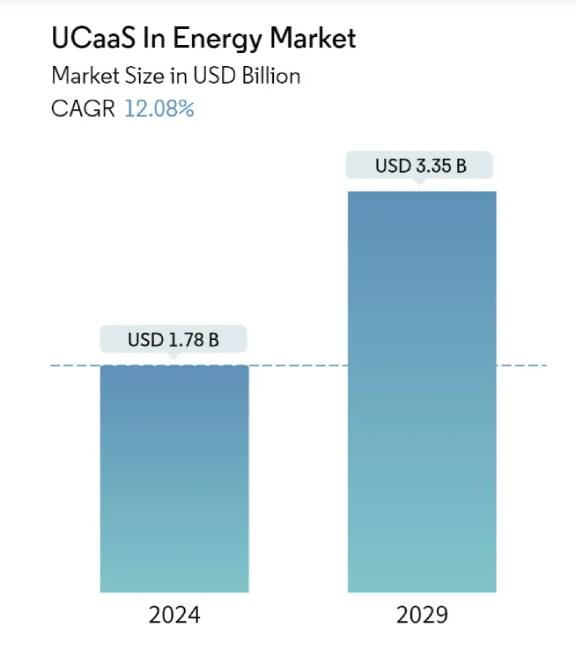Unified communications as a service (UCaaS) integrates apps and services such as call, chat, video, and audio conferencing into one cloud-based platform. Use this technology to efficiently collaborate with remote and geographically distributed teams and communicate with customers through multiple touchpoints. In this article, we’ve compiled a list of 16 UCaaS statistics to share helpful insights into this powerful communications technology.
UCaaS Statistics: Market Insights & Projections
The continued adoption of digital platforms, including chat, video conferencing, and online collaboration tools, has created new opportunities for unified communications (UC) technology and UCaaS solutions. Below are UCaaS statistics showing its global market’s development and projected market potential.
1. The UC market size is expected to reach $583.8 billion by 2032
(Source: DataHorizzon)
UC technology integrates multiple forms of enterprise communications, such as voice, video, messaging, etc., into one interface, eliminating the need for multiple vendors to manage your communication system. As technology adoption and capabilities advance, the latest UC statistics indicate the market is expected to hit over $500 billion by 2032. According to regional data, Europe has the highest growth rate in the UC market.

The UC market is valued at $115.7 billion in 2022 and is estimated to reach $538.8 billion by 2032. (Source: DataHorizzon)
2. UCaaS market size is projected to reach $85.77 billion by 2030 with a CAGR of 15.1% between 2023 & 2030
(Source: Fortune Business Insights)
The UCaaS market, valued at $28.53 billion in 2022 and $32.01 billion in 2023, is expected to hit $85.77 billion by 2030, at a compound annual growth rate (CAGR) of 15.1% during the same period. The COVID-19 pandemic led to a massive shift from traditional communications technology to cloud-based online communications and collaboration platforms.
The continued use of collaboration tools and demand for advanced solutions like online meeting applications and instant messaging help boost market growth.
3. North America is expected to dominate the UCaaS market between 2023 & 2032
(Source: Spherical Insights)
The region’s business environment will continue embracing UCaaS technology to boost productivity and integrate communication services like chat and video conferencing. Several UCaaS vendors, like Cisco and Microsoft, propel UCaaS adoption within the region. The Asia Pacific region is experiencing fast market growth, especially in India and China, which widely use voice-over-internet-protocol (VoIP) and video conferencing solutions.
UCaaS Adoption Statistics
It’s clear that UCaaS is constantly evolving and will see increased adoption worldwide. UCaaS adoption is credited with the emergence of tech-savvy small businesses, mobile-first consumers and employees, and improved infrastructure in regions like Asia, North and Latin America, and Europe. The following UCaaS statistics demonstrate the value of UCaaS and its position as a leading technology for business communications.
4. Over 50% of an enterprise’s IT spending will shift to the cloud by 2025
(Source: Gartner)
Since the COVID-19 pandemic, the shift to cloud computing has accelerated as businesses responded to the new normal and changing social dynamics. Enterprise IT’s public cloud computing spending will overtake traditional IT spending in 2025, reports Gartner, Inc. Businesses that fail to adapt to the pace of cloud technology run the risk of becoming obsolete, relegated to low-growth markets, or overtaken by competitors.
5. 80% of respondents with an on-premise private branch exchange (PBX) system intend to migrate some users to cloud services
(Source: No Jitter)
According to Omdia’s end-user survey respondents, those with an on-premise PBX phone system plan to invest in upgrading their PBX within the next five years. This indicates that cloud computing is growing despite a solid on-premise PBX market.
6. 97% of organizations reveal that remote work has increased interest in UCaaS & CCaaS
(Source: Masergy)
The right UCaaS and contact-center-as-a-service (CCaaS) solutions make remote work much easier for companies and employees because it’s portable, allowing workers to use their preferred devices and flip calls from one device to another. UCaaS technology also improves productivity by acting as a central communication hub, giving teams more flexibility and tools to communicate effectively with colleagues and clients.
7. The energy industry is investing in cloud-based UCaaS services & is expected to reach 3.35 billion by 2029
(Source: Mordor Intelligence)
UCaaS adoption within the energy industry is growing as companies invest in technology designed to support business growth instead of systems maintenance. The drivers of UCaaS adoption within the industry include increasing product commercialization and advancing industry infrastructure. UCaaS’ different communication channels, like video and chat, allow geographically separate teams to collaborate effectively and respond in real time.

The UCaaS market is expected to reach $3.35 billion by 2029, with North America being the fastest-growing industry and largest market. (Source: Mordor Intelligence)
8. IT & telecommunications are the leading industries for UCaaS adoption in 2022
(Source: Grandview Research)
In terms of industry insights, IT and telecom accounted for the largest UCaaS market share in 2022. This was mainly due to the rising adoption of UC solutions in IT companies to improve overall organizational performance. Other factors that led to high industry adoption include high numbers of cross-functional teams and remote workers. This is followed by banking, financial services, and insurance in second place and healthcare in third.
UCaaS Workplace & Productivity Statistics
Responsiveness and productivity are crucial to workplace success, especially for customer-facing teams. Using UCaaS tools helps improve employee productivity and customer responsiveness and allows teams to collaborate quickly and effectively. Here are some crucial productivity and workplace statistics you need to know.
9. 83% of workers prefer hybrid working
(Source: Accenture)
As the world enters a new normal following the COVID-19 pandemic, remote and hybrid work emerged as the dominant trend. Accenture found that 83% of workers are looking for a hybrid working arrangement, and UCaaS is one of the best ways to implement a remote working policy. Providing team members with the right tools allows them to maintain their productivity even when working away from the office.
10. UCaaS solutions & real-time collaboration enable users to make decisions 2.6 times faster
(Source: Forrester)
UCaaS supports a boost in team productivity, and firms using UCaaS make decisions 2.6 times faster than companies not using UCaaS solutions. Cloud-based services allow remote employees to continue collaborating in real time on projects across the most convenient channels. Team members can also share files, monitor projects in real time, and coordinate through different channels within the same application.
11. Less than a third of employees received guidelines on using UC tools
(Source: HubSpot)
Training ensures a smooth transition and effective adoption of UC features and functions. HubSpot’s recent report found that roughly one in three employees receive information or proper training about how to use UC solutions. A lack of training or inadequate information can negatively impact business performance, use of technology, and team morale.
When developing your training program and guidelines, tailor training to roles and focus on practical applications of the technology. Beyond the training, companies must provide users with available learning resources and ongoing support.
12. 83% of organizations need at least 30 minutes to manually onboard new users to a UCC platform
(Source: Kurmi Software and Pulse Research)
According to Kurmi Software and Pulse Research’s survey, more than 80% of its respondents need more than 30 minutes to manually onboard its new users onto its organizational unified communications and collaboration (UCC) platform. Small businesses investing in new technology must provide customers with the necessary training to develop skill sets alongside new communication technologies.
General UCaaS Statistics
UCaaS is the future of business communications as it allows users to unify all communication channels, removing the need for multiple overlapping tools. This all-in-one solution helps teams increase productivity while keeping costs low. Here are some general UCaaS stats you should know about:
13. 65% of IT leaders prefer bundled solutions
(Source: Masergy)
IT leaders say bundled solutions (a combination of products and services) are better because they’re easier to manage and integrate and better for issue resolution and cost savings. Bundled UCaaS solutions are great because they minimize hardware installations, create a single point of contact for billing, and make it easier for team members to access technology and communication tools.
14. By 2030, over 75% of companies will use UCaaS tools for calling, meeting & messaging
(Source: 8×8)
UCaaS has changed how businesses communicate by providing an employee and customer engagement solution. UCaaS adoption is driven by its key advantages, such as increased cost savings, flexibility, and staff productivity. UCaaS also integrates with CCaaS, allowing users to purchase cloud-based services on a subscription basis with minimal cost. Failure to adapt to new technology could mean losing your competitive advantage and limiting your new clients.
15. The number of smartphone users is forecasted to exceed 7.7 billion by 2028
(Source: Statista)
There were nearly 6.4 billion smartphone mobile network subscriptions in 2022, which is expected to increase to 7.7 billion by 2028. China, India, and the United States are the countries with the highest number of mobile subscriptions. Incorporating short message service (SMS) in UCaaS solutions aligns with the mobile-centric behaviors of the modern consumer.
Mobile and smartphone use has contributed to UCaaS growth because it allows employees to work smarter and more efficiently while saving money. This will enable teams to extend the reach and effectiveness of their communications.
16. Artificial intelligence (AI) will power 95% of customer interactions by 2025
(Source: Servion Global Solutions)
AI has become a vital part of business communications, including interactions via calls and online chat forums. More and more businesses will integrate automated response systems within their communication stack to help solve customers’ queries quickly and efficiently. AI in customer service takes on simpler concerns and queries so human agents can focus more on complex technical problems that require live agent intervention.
Frequently Asked Questions (FAQs)
The difference between these two cloud-based services lies in their intended usage. UCaaS focuses more on internal collaboration, while CCaaS is designed to help businesses reach customers through their preferred communication channels. Our guide on UCaaS vs CCaaS provides in-depth information about their purpose and use cases.
The global UCaaS market is driven by several critical factors, including the upsurge of remote and hybrid working, the rising trends of bring your own device (BYOD), and the growing adoption of UCaaS.
There is immense growth in UCaaS technology, especially when it comes to artificial intelligence (AI) and mobile use. To a certain extent, major UCaaS vendors have already integrated these capabilities within their software over time, and we expect to see more predictive and reactive support capabilities. UCaaS technology will lessen tedious, drudge work and make communications feel more intuitive and human.
Bottom Line
Cloud-based UCaaS systems have risen in popularity over the past decade and are seen as a powerful communication tool for businesses when implemented correctly. These UCaaS statistics show that the technology has revolutionized the way companies communicate. The technology allows companies to provide better customer experiences and support for remote and hybrid employees while ensuring security, better workflows, and greater cost savings.